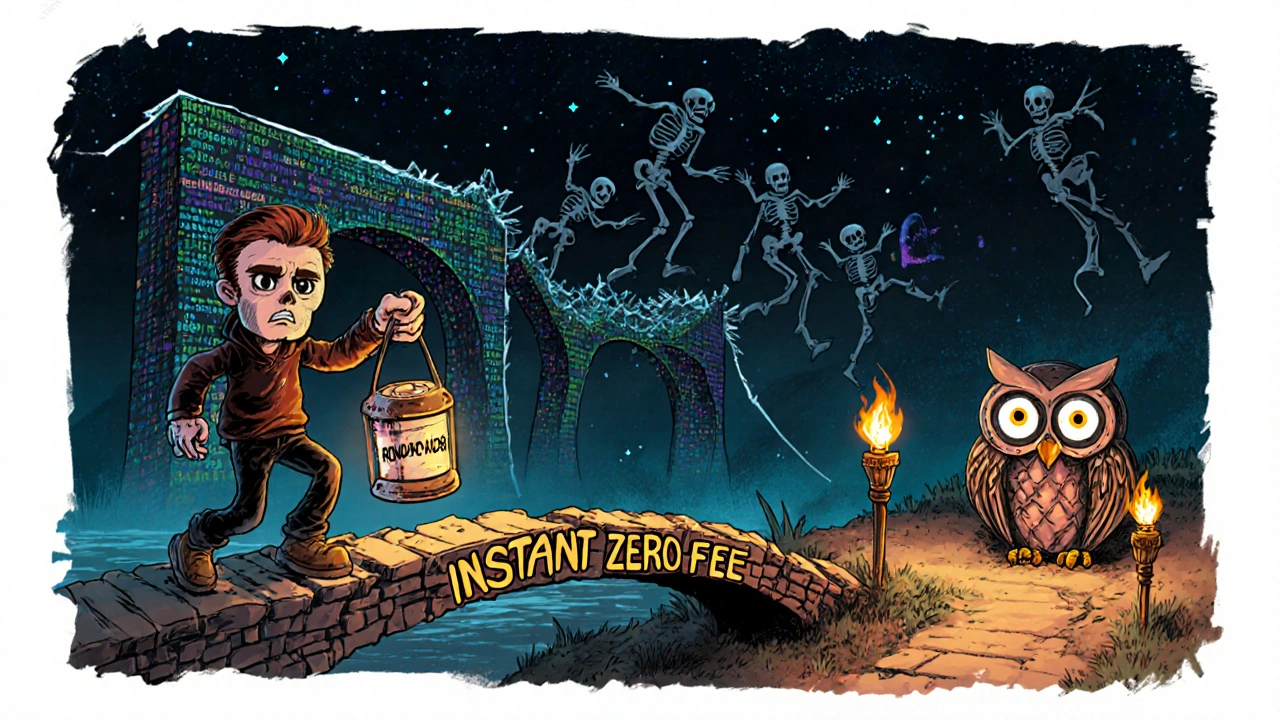Between 2022 and 2025, over $2.3 billion vanished from cross-chain bridges in just the first half of 2025 alone. That’s more than the entire year before. And it’s not random noise - every dollar lost traces back to the same core problem: bridges are designed to move value between blockchains, but they’re built like single points of failure. One weak key, one buggy contract, one typo in code - and millions disappear in minutes.
How Cross-Chain Bridges Work (And Why They’re So Dangerous)
Cross-chain bridges let you send ETH from Ethereum to SOL on Solana, or move an NFT from Avalanche to BNB Chain. They do this by locking your asset on one chain and minting a wrapped version on the other. Sounds simple? It is - until someone exploits it. The problem isn’t the math. It’s the middlemen. Most bridges rely on a small group of validators, multisig wallets, or centralized relayers to confirm transfers. That’s a single point of control. If you control those keys or the smart contract logic, you control the money. No need to break cryptography. Just find the oversight. Take Ronin Bridge. In March 2022, hackers stole $625 million by compromising five of nine private keys needed to approve transactions. Those keys weren’t stored in a vault. They were on servers. One phishing email. One misconfigured server. And $625 million was gone. The FBI called it the largest crypto theft in history. It wasn’t a hack of Ethereum. It was a hack of human error.The Top 5 Bridge Hacks and What Went Wrong
- Ronin Bridge (March 2022): $625 million lost - Five of nine multisig keys were stolen. The validator nodes were not geographically or operationally separated. One breach, total collapse.
- Wormhole (February 2022): $320 million lost - Attackers manipulated the verification step in the smart contract. Instead of checking if ETH was locked on Ethereum, the contract accepted any arbitrary value. They minted 120,000 wETH on Solana - with zero collateral.
- Nomad Bridge (August 2022): $190 million lost - A developer accidentally set the default root in the Merkle tree to 0x00. Anyone could submit a fake proof and drain funds. Within hours, users rushed to withdraw, thinking it was a bug - but it was a free money exploit.
- Binance Bridge (October 2022): $570 million lost - The IAVL Merkle proof system failed to validate tree structure properly. Attackers crafted fake proofs that looked valid. Binance had to freeze withdrawals and roll back transactions.
- Socket Interoperability Protocol (January 2024): $12 million lost - Wallets with infinite approvals to Socket’s contract were drained. Users had granted unlimited access months earlier. No one revoked it. The bridge didn’t check limits.
Why These Hacks Keep Happening
The industry treats bridges like apps you download - install, use, forget. But bridges hold billions. They’re not software. They’re financial infrastructure. Most teams rush to launch. They want to support 15 chains by next quarter. They skip audits. They cut corners on multisig thresholds. They use the same team that built the token to secure the bridge. It’s like hiring a pizza delivery driver to run your bank vault. Even worse - many bridges still use custodial models. Your funds aren’t locked in a smart contract. They’re sitting in a wallet controlled by a CEO or a small team. If that person gets hacked, or decides to leave, or gets pressured - your money is gone. The Ronin hack proved that. The Multichain hack in 2023? Same thing. CEO’s private key was compromised. And the worst part? Users don’t know the difference. They see ‘Bridge to Solana’ on their wallet and click. They don’t ask: Who holds the keys? How many signatures are needed? Is this audited? They assume it’s safe because it’s on a popular platform.
What’s Changed Since the Big Hacks?
Some projects learned. Wormhole didn’t just patch the bug. They rebuilt. They doubled their audit budget. Launched a $5 million bug bounty. Moved to decentralized governance. Now, no single entity controls the bridge. It’s run by a council of validators across multiple jurisdictions. Symbiosis.finance took a different path. They replaced multisig with MPC (Multi-Party Computation) relayers. No single key exists. Transactions require collaboration between 10+ nodes - none of which can act alone. Even if one node is compromised, it can’t sign a transaction. This model now secures over $12 billion across 45+ chains as of 2025. Chainlink’s CCIP is going enterprise-grade. It uses off-chain oracle networks to verify state across chains. No centralized relayer. No single point of failure. It’s slower, more expensive, but designed for institutions. Not for hype. But here’s the truth: most new bridges still use the old models. The market rewards speed over safety. New projects still launch with 3-of-5 multisig. Still use centralized relayers. Still don’t publish full audit reports.How to Use Bridges Safely in 2025
If you’re moving assets across chains, don’t just pick the one with the lowest fee. Ask these questions:- Who holds the keys? Is it a multisig? How many signers? Are they spread across different entities? Or is it one person’s wallet?
- Is it non-custodial? Can you prove your funds are locked in a verifiable smart contract - not in a wallet controlled by a company?
- Has it been audited by two or more reputable firms? Look for reports from CertiK, PeckShield, or Trail of Bits. If they only did one audit - walk away.
- What’s the recovery plan? Did they launch a bug bounty? Do they have insurance? Or are you on your own if it fails?
- Are approvals limited? Never give infinite approval to any bridge contract. Always set a cap. Use tools like Revoke.cash to check and revoke permissions.

The Future of Cross-Chain Security
The academic paper by N. Belenkov (2025) says it best: ‘The architecture of bridges is still experimental.’ We’re building bridges while traffic is flowing. No one has a perfect blueprint. But the direction is clear. The future belongs to:- Non-custodial designs
- MPC-based relayers
- Decentralized validator sets
- On-chain verification with cryptographic proofs
Final Thought: Trust, But Verify
Cross-chain bridges are necessary. Without them, DeFi is stuck in silos. But they’re also the most dangerous part of Web3. Every exploit proves the same thing: when money moves across chains, the weakest link isn’t the blockchain. It’s the bridge. Don’t use a bridge because it’s popular. Use it because it’s secure. And if you can’t find proof of that - wait. Build your own bridge. Or just use a centralized exchange. At least there, you know who’s responsible.What is the most common cause of cross-chain bridge hacks?
The most common cause is compromised private keys, especially in multisig setups where too few keys are required to authorize transactions. Other top causes include flawed smart contract logic - like incorrect Merkle proof verification, default accepted root values, and infinite approval flaws. Human error, not cryptographic failure, is the real vulnerability.
Which bridge hack was the largest in history?
The Ronin Bridge hack in March 2022 remains the largest, with $625 million stolen after North Korean hacker group Lazarus compromised five of nine validator keys. This breach surpassed all previous crypto thefts and led to the FBI’s public involvement.
Are all cross-chain bridges unsafe?
No. Some bridges, like Symbiosis.finance (using MPC relayers) and Chainlink’s CCIP, have significantly improved security models. These avoid centralized key control and use cryptographic verification across multiple nodes. But most newer or smaller bridges still rely on outdated, risky architectures. Always check the design before using one.
How can I protect myself when using a bridge?
Only use bridges with public, recent audits from reputable firms. Avoid infinite approvals - set spending limits. Use tools like Revoke.cash to check and revoke permissions. Prefer non-custodial bridges with decentralized validators. Never send large amounts without testing with a small transaction first.
What’s the difference between MPC and multisig bridges?
Multisig requires multiple private keys to sign a transaction - if one key is stolen, the whole system is at risk. MPC (Multi-Party Computation) breaks the key into shares distributed across nodes. No single node holds a full key. Even if several nodes are compromised, they can’t reconstruct the key or sign a transaction. MPC is more secure and is now used by top bridges like Symbiosis.finance.
Is it safer to use a centralized exchange instead of a bridge?
For large transfers, yes - if you trust the exchange. Centralized exchanges like Binance or Coinbase hold assets in regulated custodial accounts. While they’re not perfect, they have insurance, legal teams, and compliance. Bridges, especially newer ones, often have no legal recourse if hacked. If you need to move funds between chains, use a bridge only when necessary - and always prefer the most secure option available.


